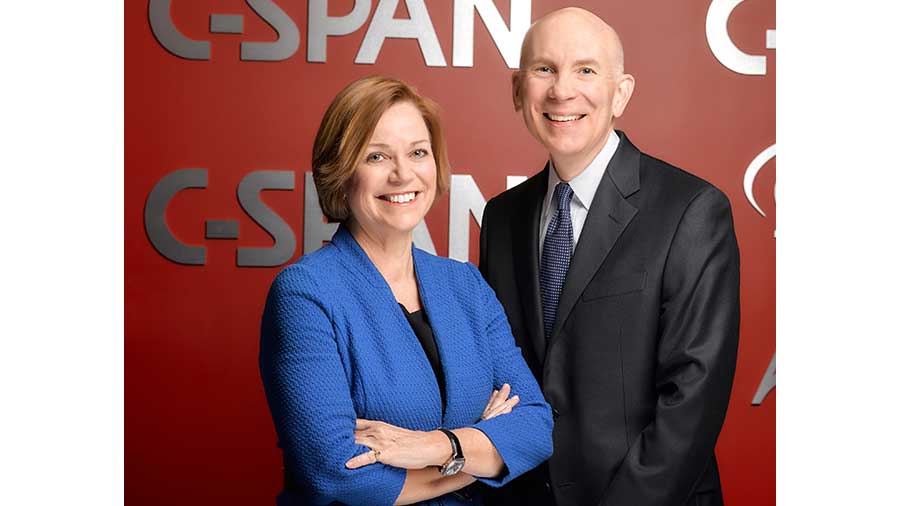Susan Swain and Robert Kennedy

Related: Welcome to the 27th Annual ‘Broadcasting & Cable’ Hall of Fame
When C-SPAN founder Brian Lamb opted to step back from the CEO role when he turned 70, his succession plan was all set. Top lieutenants Susan Swain, who oversees programming and is a well-known on-air host, and Robert Kennedy, the operations and finance expert, were ready to become president and co-CEO in 2012.
That’s an unusual management arrangement at an organization that is already an anomaly: a nonprofit, public-affairs programmer funded by the pay TV industry.
Lamb had secured the C-SPAN board’s support well in advance. It doesn’t seem to have been a hard sell, though.
“We said to ourselves, you know, if it doesn’t work, it doesn’t work. But we all thought it would work,” Robert Miron, the longtime board chairman (now senior director) at C-SPAN, said. “We thought Brian was very key to making it start. And Rob and Susan have kept things rolling.”
Kennedy and Swain, who have been at C-SPAN for more than 30 years, were well known to Miron and the other directors.
Working out of adjoining offices since the late 1980s, they’ve been key to the expansion from a single network to a programmer with three video channels, a radio station and multiple websites.
“You go to any business school, I don’t think they teach a dual-role leadership,” Patrick Esser, the president of Cox Communications and another C-SPAN director and former executive committee chairman who’s worked closely with the co-CEOs, said.
“You don’t find that very often, so you kind of tilt your head. But because of the unique qualities of the two of them and their career experiences, it works extremely well, and it is impressive to see how they utilize each other’s strengths.”
In a collective interview, Swain and Kennedy (who in 2004 shared the NCTA Vanguard Award for Programmers) said it helps their partnership that their interests are complementary. Swain has the “software” side and Kennedy the “hardware,” to use Swain’s analogy.
“The other thing is that we just really get along,” Kennedy said.
“Early on, as we got in these roles, we said the one rule that we would always have is no surprises, or fast ones as we called it at one point,” he said.
They make all the strategic decisions together, in a collaborative fashion that also includes senior management staff, Swain noted.
Neither can recall any “knock-down, drag-out” divergences of opinion. But on occasion, Swain said, they have been unable to agree and then brought in Lamb for another view on the subject.
“The problem with that is, what Brian wants to do, tends to trump,” she said.
“So it’s up to you to find a third way,” Kennedy added.
Lamb, now C-SPAN executive chairman, told B&C Hall of Fame producers in an interview that Swain and Kennedy “always cue each other in on what’s going on, and that’s not easy to do.”
He said they have built trust among the ranks of C-SPAN staff over the years by doing what they say they are going to do and not overspending. They project calmness, he said, unlike Lamb himself.
“Rob is a stickler for the decision process,” Lamb added. “Susan would probably bend it from time to time, but that’s necessary; you’ve got to be somewhat flexible. She’s rather persuasive when she wants something, and he’s smart as a whip. They both are.”
Swain has led C-SPAN beyond its core, unfiltered coverage of Congress into weekend BookTV and American History TV programming blocks, as well as admired campaign coverage and historical perspective series (American Presidents, The Lincoln-Douglas Debates).
Kennedy — who first came to C-SPAN as an outside consultant to write its first-ever five-year plan — became the top financial officer in 1987 and has guided its expansion, including through such significant moves as the purchase of a radio station in 1997.
“It started as our radio station, and now it’s our app, it’s TuneIn, it’s Stitcher, you can listen to C-SPAN Radio on your Amazon Echo with Alexa in the morning,” he said. “It’s really put us in the world of audio programming.”
Both appreciate having had rare access to great U.S. entrepreneurs, such as Miron; the late Bill Bresnan; longtime directors Amos Hostetter and John Evans; Esser’s predecessor at Cox, Jim Robbins; and now Esser and Charter Communications CEO Tom Rutledge, among other leaders and supporters of C-SPAN.
As for C-SPAN’s role in the world, Esser said it is “probably much more valued today than ever” in a time of intense interest in public affairs and different sets of news filters.
“In the age of social media and commentary, just to get the information yourself is very, very helpful,” he said. “We live in a day and age where you need to open the doors so we as U.S. citizens can see what’s going on in our government, and there’s not many places I have found you can go other than to C-SPAN to get it very straight.”
Broadcasting & Cable Newsletter
The smarter way to stay on top of broadcasting and cable industry. Sign up below
Kent has been a journalist, writer and editor at Multichannel News since 1994 and with Broadcasting+Cable since 2010. He is a good point of contact for anything editorial at the publications and for Nexttv.com. Before joining Multichannel News he had been a newspaper reporter with publications including The Washington Times, The Poughkeepsie (N.Y.) Journal and North County News.

